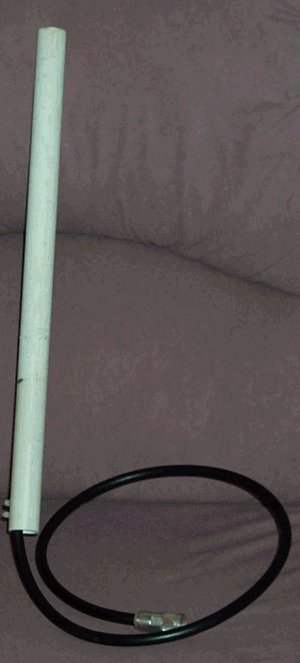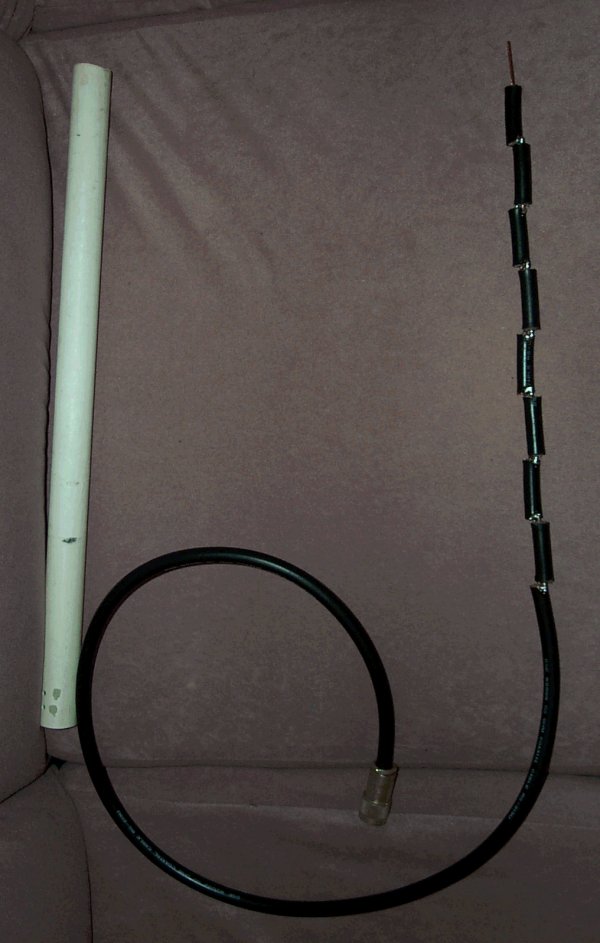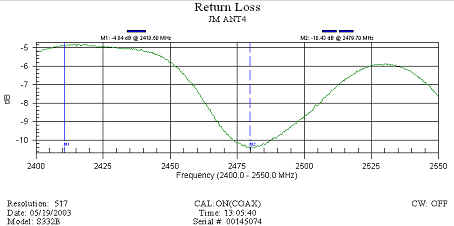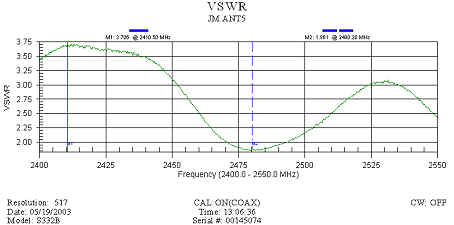
Build a 2.4GHz Co-linear antenna
(for Wireless Access Points)
The instructions are here at Easy Homemade 2.4Ghz Omni Antenna
or you can also find them here or even if nothing works, I have a local copy.
Here are some pictures of the one I made to guide you. I didn't make a jig - I just used 2 'G' clamps to hold the coax to the desk whilst I soldered it. I found that the hardest part was making up the coax sections to exactly 37mm and getting them 37mm long all the way around the coax.The RG213 was purchased from Dick Smith Electronics and a 1 metre lead was used at the one end with an 'N' type male connector. The thing I forgot was to leave the insulation on the centre conductor for the last 1/4 wavelength section - (as can be seen in the photo below).. but then again I followed the instructions literally... oh well, I can always put another one together.
Here are the theoretical gains to be achieved, depending upon how many bits of coax you chop up-
| Antenna Gain (dB) | No. of elements | Approx. length of antenna (mm) |
| 3.5 | 4 | 320 |
| 6 | 8 | 560 |
| 9 | 18 | 1160 |
| 10 | 21 | 1340 |
By using 8 elements as in the above design - a gain of 6dB was expected. A quick check with Netstumbler using my own access point at the other side of the house indicated around 6dB gain - or rather the S/N was improved by 6dB. In actual fact I noticed the noise floor drop more than the signal gain - but that amounted to more S/N.



Here are the measurements for my first attempt at one of these things using an Anritsu antenna analyser at work during lunchtime. Looks like I should lengthen everything by 1mm or so and try again to bring the resonance point down from Wireless Ch 13++ downwards!.
The return loss measurement (10.4dB at 2480MHz) not crash hot:

Or for those who prefer VSWR graphs (1.8:1 at 2480MHz):

In case you need them - here are the 802.11b wireless network channel details:
IEEE 802.11b (Wi-Fi) uses Direct Sequence Spread Spectrum, with data rates up to 11 Mb/sec. There are 13x 22 MHz wide channels (5 MHz apart) in the 83.5 MHz allocation of the 2.4 GHz band. A maximum of three networks can occupy this spectrum without interference. The ACA states that 4W EIRP is the maximum power allowed in Australia. The official standard can be read about here.
Here are the channels:
| Channel: | Frequency (MHz): |
| 1 | 2412 |
| 2 | 2417 |
| 3 | 2422 |
| 4 | 2427 |
| 5 | 2432 |
| 6 | 2437 |
| 7 | 2442 |
| 8 | 2447 |
| 9 | 2452 |
| 10 | 2457 |
| 11 | 2462 |
| 12 | 2467 |
| 13 | 2472 |
Doh - looks like my antenna is just not quite cut correctly! So who measured everything I wonder? The gain is okay, but the VSWR is no good on the wireless channels. So I think either the calculations were a little bit out or the velocity factor of DSE RG213 is not quite the same as other brands. So it's back to the drawing board for another few hours one weekend! Some mention in the original article was made of a 'decoupler' or similar device (which should probably be used - but like the author, I omitted it for simplicity). I suspect that it would be a better idea to add one as putting my hand around the bottom of the antenna at it's feedpoint changed the return loss peak to a much better value. I might try adding a quarter wavelength coax shield or something around the bottom of the antenna in the next design and see what difference this makes.
An interesting point is that the dimensions of 40.5mm are fairly critical. It looks like if the shield is a bit sloppy when cut and the joins aren't made accurately, the antenna tuning will change. At 2400MHz the half wavelength is 41.2mm, at 2441MHz (ch7?) the measurement is 40.5mm and at 2480MHz where this antenna resonates, the measurement is 39.9mm. So for 0.6mm difference, the resonant frequency has shifted a fair way. I suspect if I followed the whole procedure again and cut the 37mm elements, but joined them at 41mm or 41.5mm then I would most likely be in the 2400-2450 band segment when the antenna is tested.
Stay tuned....
Only a quick look - check the links at the top of the page to go and build your own.